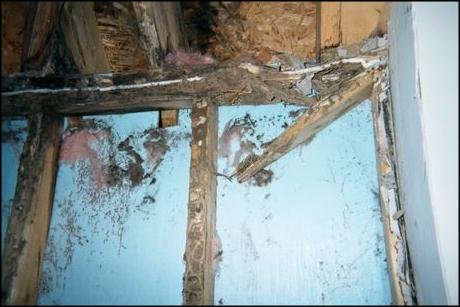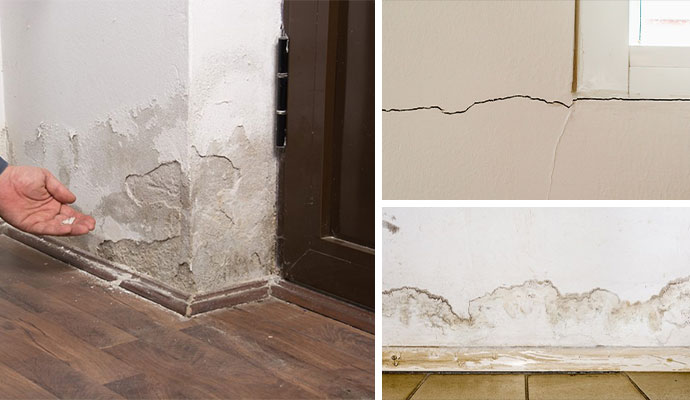We have unearthed the article on How to Find and Repair Water Leaking in the Wall down the page on the net and figured it made good sense to relate it with you over here.

Water discolorations on wall surfaces are not enjoyable to the eyes. Your home must be without discolorations on the walls, roofing system, or floorings. That is the suitable state of a house and also its frameworks. Yet, in some cases it appears virtually inescapable to experience water spots on walls in homes.
Homeowners living in damp areas continuously deal with the anxiety of water spots on wall surfaces. With all-around as well as exact info on the reasons of water discolorations and punctual fixing processes, you will always be a step in advance of such events.
3 Common Causes of Water Stains on Walls
Unlike popular belief, water stains on walls do not always stem from poor building materials. There are several root causes of water spots on wall surfaces. These consist of:
Poor Water drainage
When making a building plan, it is crucial to make sure adequate drainage. This will protect against water from seeping into the wall surfaces. Where the water drainage system is obstructed or nonexistent, below ground wetness builds up. This links to too much moisture that you observe on the wall surfaces of your structure.
The leading reason of damp wall surfaces, in this case, can be a poor drain system. It can likewise result from poor monitoring of sewage pipelines that run through the structure.
Moist
When hot moist air meets with completely dry cool air, it causes water droplets to form on the wall surfaces of buildings. When there is heavy steam from cooking or showers, this occurs in cooking areas and also washrooms. The water beads can stain the surrounding walls in these parts of your residence as well as infect other areas.
Wet or condensation impacts the roof and wall surfaces of buildings. When the wall surface is damp, it creates an appropriate setting for the growth of microbes as well as fungi.
Pipe Leaks
Many residences have a network of water pipelines within the wall surfaces. It constantly raises the viability of such pipelines, as there is little oxygen within the walls.
Yet, a drawback to this is that water leak affects the walls of the building and triggers prevalent damages. A telltale sign of malfunctioning pipes is the appearance of a water tarnish on the wall surface.
Water Stains on Wall Surface: Repair Service Tips
Home owners would normally want a quick fix when taking care of water discolorations. They would soon understand this is detrimental as the water discolorations reoccur. So, right here are a couple of valuable ideas that will certainly assist you in the repair of water discolorations on walls:
Pro Pointer
A houseplant in your house additionally raises its moisture. So, if your home is currently humid, you might intend to present houseplants with marginal transpiration. An instance of appropriate houseplants is succulents.
Verdict
Although nobody wishes to have water discolorations on walls in their house, it can occur to the best people. This article provides you utilize, as you currently know how to manage this incident if it does happen.
It is always best to hire expert solutions to help take care of the problems in your home.
Sometimes it appears practically unpreventable to experience water stains on walls in homes.
Contrary to preferred idea, water discolorations on walls do not constantly stem from poor building products. There are a number of causes of water stains on wall surfaces. The water droplets can stain the surrounding wall surfaces in these components of your home and also spread to various other locations.
Below are a couple of helpful tips that will certainly assist you in the fixing of water stains on walls:
What To Do About A Water Stain On The Ceiling
Why This is Important
Not only are water stains a cosmetic issue, but they can also indicate that there is a leak in the home that needs to be fixed. Sometimes, this may be the first indicator of a bigger problem brewing or may have been a one time leaky issue. It is important to investigate to make sure it is under control before you possibly have thousands of dollars in repairs.
Identify the Cause of the Water Stain on the Ceiling and Where to Start
It is important to identify the cause of the water stain on the ceiling first so you can fix it. Start first with the roof to see if there are leaky shingles or missing shingles, missing flashing, or weakened seals around roof vents. You may need to get on top of the roof to look or call a professional to check for you. It is possible that water is coming into the home from the roof. So you will want to have the professional take a look to see if this is the issue.
Also, look in the attic to see if there is a pool of water and that will also help you to know if there is water leaking into the home.
Radiator or Air Handler on 2nd floor
In colder parts of the country, there may be a radiator on the second floor. Radiators are used to keep rooms warm in the cold months and do wear out or need replacing. Does the radiator have a pool of water underneath it or any dripping? If yes, this could be the problem and causing the water stain on the ceiling. Check the model of the radiator and see if it is something you can do yourself or call a professional to check the body, pipe, and the valve for leaks.
The same is true for those who have an air handler on the second floor. Did your AC stop working? Or do you see water leaking? The drip pan (if you have one) on an HVAC unit collects the water and it can become clogged and back up. The float switch (again, if you have one) will activate as soon as the water reaches a certain level and shut down the HVAC unit, thus not allowing the water to continue to flow. Make sure the HVAC doesn’t become clogged and checking this monthly is a good idea.
Upstairs Bathroom Can Cause a Water Stain on the Ceiling
Bathrooms are often the culprit as caulking wears out after about 10 years and needs replacing. Is the home older than 10 years? This may be the issue. While checking the caulking in the bathroom around the sinks, toilets, and shower/bath, also check for black mold in the shower. Might as well rule everything out while you are looking for the source.
Other areas to look at are toilets clogging and overflowing. Do you see water near the toilet on the floor? This could be the seal is broken on the toilet and it needs replacing. Also, adding caulk to the toilet to connect it to the floor is a good idea. If the toilet is continuously running, you can shut off the water and do the water meter test.
Write down the number on the water meter and then turn off the water for three hours. When you turn it back on, check the number on the water meter. If it has increased, then you have a leak in the indoor plumbing.
Taking care of these areas is essential as sewer gases can also be escaping. Sometimes these issues will soak the ceiling below and clog in sinks and drains in the shower can also cause flooding in a bathroom.
Put a Drop Cloth on the Floor
With goggles on and gloves, put a drop cloth on the floor. Then, take 3 glasses of warm water and one cup of bleach and mix it together. Set up a ladder and climb up to the stain. Use a sponge that is soaked in the concoction to rub it on the water stain to get it to come off. Take a spray bottle of plain water and spray the stain to get the bleach mixture off. This is important because you want to be able to prime it and paint it. Take a dry towel and rub the stain to help it dry faster. Next, put painters tape around the ceiling if the spot is near the walls. Apply an Oil Based, Stain Blocking Primer
Apply an oil based, stain blocking primer that is mold resistant that matches the ceiling. It is important to put the primer on first so the paint doesn’t soak into the ceiling. If you have a flat ceiling, you can use a paint roller with an extension to apply it. Once the primer has dried, apply the paint. If you have a textured ceiling, a spray on primer might work better.
Choose a Latex or Alkyd Ceiling Paint
The latex ceiling paint is water-based and dries faster than the oil-based paints and also is thicker than wall paint. Make sure that the paint matches the ceiling color. Using a roller, paint it on over the primer and let it dry for up to four hours. Then, apply a second coat and let it dry. The second coat should make the stain disappear.
https://insideandoutpropertyinspectors.com/water-stain-on-ceiling/

I was made aware of that article about How to Find and Repair Water Leaking in the Wall from someone on another domain. Enjoyed reading our blog? Please share it. Let others find it. We truly appreciate reading our article about .
Solve now, call!